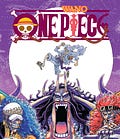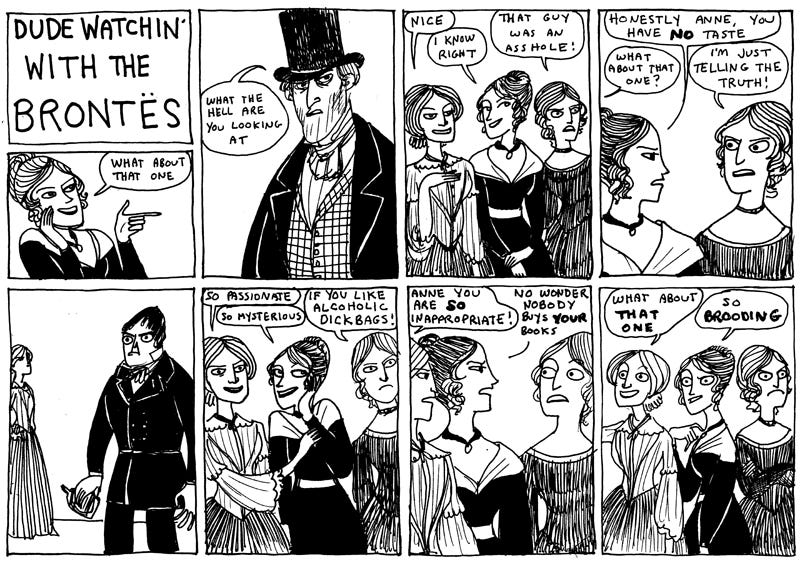50 favorite comics of the 21st century
I finished My Favorite Thing Is Monsters, so let's finally do this
Usual disclaimer: I’ve read a lot of comics (a lot) but hardly everything; in manga alone I have a to-do list that’ll take years, stretching to decades in the unlikely event that I ever learn Japanese properly. Anything either first published or first published in book form since 2000 is eligible; translations or straight reissues of older work don’t count (saving those for my favorite comics of the 20th century list, speaking of multidecade projects.) One Piece (started 1997) counts; Dragon Ball (RIP Toriyama but the best stuff was done by ’93) doesn’t. Fifty is two per year which is Not Much, so many beloved artists miss out; sorry, Michael DeForge. Lots of stuff here I’ve talked about before, so if I don’t have anything new to say I’ll just link to past writing.
1. Emil Ferris: My Favorite Thing Is Monsters
Somehow, despite health problems, Fantagraphics suing her, and credible threats to set the whole thing on fire, she got the darn thing finished and published earlier this year. Book Two is admittedly rougher than Book One—a few pages are clearly in “just get it done” mode (which certain manga creators below would do well to adopt sometimes)—so perhaps it’s merely comic of the year. The main storyline simplifies into a coming-of-age, until at a late stage it slips away from any neat summation beyond maybe art is weird; that’s why we weirdos like it. The narrative is gripping, the art is astonishing when necessary or desired (the Ghastly covers, anything at the Art Institute of Chicago), and the ending will keep interpreters busy for a while.
2. Chris Ware: Jimmy Corrigan: The Smartest Kid on Earth
At this distance, it’s hardly worth complaining about the limitations of Ware’s worldview and themes—yeah you have crippling shyness and parental issues, who doesn’t have at least one out of two. In the early 2000s, I wondered whether his innovations would still be impressive after they were inevitably copied. I can now safely say: hell yeah. The way his paneling and the geometry of his compositions reinforce each other is something nobody else has successfully replicated (maybe including himself, though his quixotic attempt to extend it to a third dimension in Building Stories was a nice try.) And among the scores of artists to do faux turn of the 20th century stuff, Ware’s almost the only one (Pynchon too, maybe) to get what modernism meant at the time: that Mallarmé throwing words all over the page or Duchamp going to the restroom weren’t just because it looked cool. Rest assured, though: it does look cool.
3. Tatsuki Fujimoto: Chainsaw Man (tr. Amanda Haley)
4. Anders Nilsen: Big Questions
5. Eiichiro Oda: One Piece (tr. Stephen Paul)
We’re past the 20,000 page mark, and perhaps uniquely among epics of comparable magnitude, the universe keeps expanding and the author remains focused and in control of the whole of their material (an American comic would be on to its fourth reboot by now.) It hasn’t been without its lulls—after the timeskip, it took most of the 2010s to recover the pitch it attained during the Water 7/Summit War—but it’s firmly back now. And now that he’s found Gear Five, Oda’s just about alone among manga creators in that his fanbase is absolutely relaxed about his chances of sticking the landing.
6. Grant Morrison/Chris Weston/Gary Erskine: The Filth
7. Yoshihiro Togashi: Hunter x Hunter (tr. Lillian Olsen)
8. Eleanor Davis: The Hard Tomorrow
9. Charles Burns: Black Hole
Definitely the only book on this list to inspire as many as three Wussy songs (“I’m shedding my skin/So far down a hole/I can never go home.”) Amidst the disease-as-metaphor and general horror, its great achievement might be its evocation of high school (and its hairstyles) as something outside of time, something that compels you to mark out some space, physical and/or emotional, as your own to preserve some attachment to existing reality. What form this takes might depend on exactly how horny you are, but let’s be honest, the answer is probably “very”. On top of that, Burns might have the best outdoor night scenes since Herriman.
10. Tatsuki Fujimoto: Look Back (tr. Amanda Haley)
11. Ryan North & Erica Henderson: The Unbeatable Squirrel Girl
12. Taiyo Matsumoto: Sunny (tr. Michael Arias)
13. Lewis Trondheim: Ralph Azham (tr. Joe Johnson)
14. Lee Lai: Stone Fruit
15. Grant Morrison/Frank Quitely/Jamie Grant: All-Star Superman
16. Jillian Tamaki: SuperMutant Magic Academy
17. Jaime Hernandez: The Love Bunglers
18. Naoki Urasawa: 20th Century Boys (tr. Akemi Wegmüller)
19. Joe Sacco: Footnotes in Gaza
Sacco stands alone in his willingness to do the legwork of reportage and, while he inevitably becomes one of his own characters, he makes sure he’s not the focus of his work. That would be the older Gazans who remember the 1956 Khan Younis and Rafah massacres, and while Sacco notes their memories aren’t completely consistent with each other, that doesn’t mean the truth can’t be approached. The only way this book is dated is that the death tolls of hundreds were, at the time and when Sacco researched the book in 2002–03, of almost unimaginable magnitude. Now, well, fuck.
20. Kanehito Yamada & Tsukasa Abe: Frieren: Beyond Journey’s End (tr. Misa ‘Japanese Ammo’)
21. Haruichi Furudate: Haikyu!! (tr. Adrienne Beck)
22. Kate Beaton: Hark! A Vagrant!
I’m glad she’s a proper comic artist now, but even if these webcomics aren’t her most important work, they still have a charm and sense of life that only naïve art can produce, with exaggerated faces, atypical body shapes, and arms and legs doing thing limbs aren’t supposed to do. The subject matter is the usual: fat ponies! Napoleon! Sexy Batman! More Canadian history than you thought you wanted to know! More trenchant criticism of the Brontës than Kate Bush’s!
23. Lale Westvind: Grip
24. David B.: Epileptic (tr. Kim Thompson)
David B. fits into the wider current of art and literature as well as anyone on this list. There’s an intermittently tender/violent relationship with his brother, there are dreams that may or may not mean anything. There’s a history of the intersection between hippiedom and occultists in France in the Sixties. There’s endless chiaroscuro, in which a striped shirt or a set of wrinkles can appear luminescent. There’s probably the best use of posture to express character and mood since peak Looney Tunes.
25. Tatsuki Fujimoto: Goodbye, Eri (tr. Amanda Haley)
26. Kieron Gillen & Jamie McKelvie: The Wicked + the Divine
27. Kieron Gillen & Jamie McKelvie: Young Avengers
28. Marguerite Abouet & Clément Obrerie: Aya of Yop City
29. Takehiko Inoue: Vagabond (tr. Yuji Oniki)
30. Mariko & Jillian Tamaki: Roaming
Friends go to New York and make out and fight and do all that young adult stuff that no one puts on paper better than the Tamakis, without it ever getting heavy-handed. The drawing is characteristically amazing, psychologically astute while capturing the sense of possibility presented by the Met or the subway or just population density to a kid from anywhere else in the New World. Almost makes me wish I did my young adult pilgrimage to NYC with other people instead of going by myself, but not quite: sometimes you want it to be you and the pre-Raphaelites.
31. Yukinobu Tatsu: Dandadan (tr. Kumar Sivasubramanian)
32. Tillie Walden: On a Sunbeam
33. Randall Munroe: xkcd
Back when this was a clever but very nerd-bro strip, I wouldn’t have guessed that this’d be the 2000s webcomic to hit 3000 editions while staying true to the concept it stabilized at around issue 500 and without descending into repetition or self-parody. Science: it progresses, and sometimes people do too! Click and Drag is the classic, Words That End in Gry still the most crucial for positive-sum Internet communication.
34. Toranosuke Shimada: Robo Sapiens: Tales of Tomorrow (tr. Adrienne Beck)
The scope of this single tankobon is amazing: the chronology starts with cave paintings and ends with (some version of) the Singularity. Looks great too, with futuristic designs that almost resolve into text but not quite. The narrative is sentimental without detracting from the depth of the questions under examination: what’s left of humanity once physical humans are gone? Cave paintings, for a start.
35. Hideaki Sorachi: Gintama (unofficial translation by Hi Wa Mata Noboru)
36. Carol Swain: Gast
37. Aaron McGruder: The Boondocks
Now that every other Twitter user is Huey except marginally less funny and entirely lacking in self-awareness, you kids might not realize how valuable this was for us old school annoying leftists, however brief its anti-imperial phase was. Then he got bored of drawing the strip and got TV money and now I presume he lives in a hilltop mansion in a pile of cash and small arms. Which is still better character development than Jazmine got.
38. Chris Ware: Lint
39. Jason Lutes: Berlin
40. Alison Bechdel: Fun Home
Still holds up despite there being a million subsequent “my family was weird and also I’m gay” graphic memoirs. Helps that Bechdel has a secrets-and-lies family history to work with, but more important is that she can really draw. On re-reading I noticed the variety of facial expressions; there are so many different kinds of boredness.
41. Yuto Suzuki: Sakamoto Days (tr. Camellia Nieh)
42. Rick Remender/Jerome Opeña et al.: Uncanny X-Force
Beats out Grant Morrison for the most entertaining X-book since Claremont, with an actual through-line plot, not too much distracting continuity bullshit to distract, and (most unprecedentedly for Marvel) convincing adult sexuality. Opeña is one of the few artists to create a distinctive look for 2010s superheroes that wasn’t hopelessly retro.
43. Joe Sacco: Paying the Land
44. Nicholas Gurewitch: The Perry Bible Fellowship
Among the 2000s Shock Jock webcomics, this has endured mostly because for the last sixteen years Gurewitch has only published when he’s actually had something to draw with his jarring tonal mix that Bosch would be proud of, theology notwithstanding. Now let’s fight/make out with (a) God.
45. Bill Griffiths: Invisible Ink
46. Yumi Hotta & Takeshi Obata: Hikaru No Go (tr. Andy Nakatani, Naoko Amemiya)
47. Marjane Satrapi: Persepolis (tr. Ferris/Ripa/Singh)
Primarily for the first (English) book, for its depiction of middle-class life before and during the Revolution as much as for its child’s-eye-view of politics, though book two’s outsider’s view of Vienna has its chills.









Ever read the Loki run by Gillen, et al?
Stone fruit! What a fucking incredible debut.